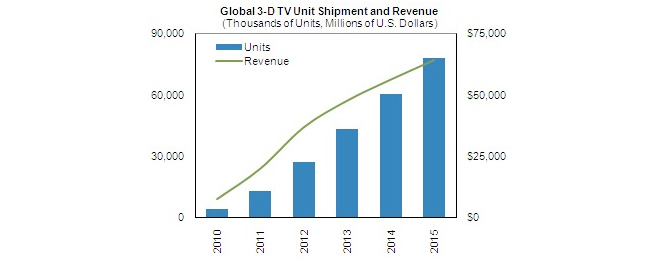Europe's online source of news, data & analysis for professionals involved in packaged media and new delivery technologies

'Global 3D TV shipments set to soar to 78 million units in 2015'
Global 3D television shipments will soar to 78 million units by 2015, rising at a compound annual growth rate of 80% from 4.2 million in 2010, iSuppli predicts. Revenue from shipments of these sets will boom to $64.4 billion in 2015, up by nearly a factor of nine from $7.4 billion in 2010.
“While 3D television has been all the rage in the consumer electronics industry, the market so far has been more talk than action,” said Riddhi Patel, director of television system research at iSuppli. “However, announcements made before and after the 2010 Consumer Electronics Show in January indicate that 3D TV is becoming a reality. At the event, top television brands including Sony, LG, Panasonic and Samsung showcased upcoming offerings of full-featured 3D TVs in the home. Furthermore, consumer electronics makers at CES announced 3-D Blu-ray players and home theater systems, providing critical support that will help 3-D to move beyond a niche market and enter the mainstream in the coming years.”
Because of this strong brand commitment, competition in the 3D market is expected to be intense, causing prices to plunge. The global Average Selling Price for 3D TVs is set to drop to $825 by 2015, less than half the $1,768 ASP in 2010. This will make 3D TVs attractive to worldwide consumers.
iSuppli’s forecast assumes that brands will roll out their initial 3D television sets starting in the first quarter and continue through the second half of the year. Many of the initial 3D TV sets, designed to test the waters of the market and gauge consumer interest, will command a price premium of $600 to $700 compared to 2D LCD-TVs using Light Emitting Diode backlighting.
iSuppli predicts that early adopters alone will purchase 3D TVs in 2010 and 2011. However, by 2012 and beyond, sales will spread to a wider audience as content availability increases and prices drop – factors that will enable 3D TVs to appeal to a wider audience.
Content is starting to become available this year from ESPN, DirecTV, BSkyB, SkyLife and other broadcasters and providers. ESPN, for example, will be broadcasting 85 games in 3D this year. Moreover 40 to 50 gaming titles in 3D are expected to be issued in 2010.
One concern for the television industry is that special glasses are required for consumers to actually see 3D images.
These glasses raise a number of questions. Will eyewear be compatible with other sets, either from the same or from different brands? Do consumers want to wear the glasses for extended periods – or will extended wearing be uncomfortable? And beyond the price of the 3D set, how much will the glasses cost? Some quarters surmise that the glasses could be as much as $300 a pair – which would prove prohibitive for an average family to afford.
One way that some OEMs are working around this issue is by including two pairs of glasses with their 3D sets. These bundles would then take away the price of the glasses and give consumers the capability to view 3D immediately, says iSuppli.

Story filed 02.03.10




















